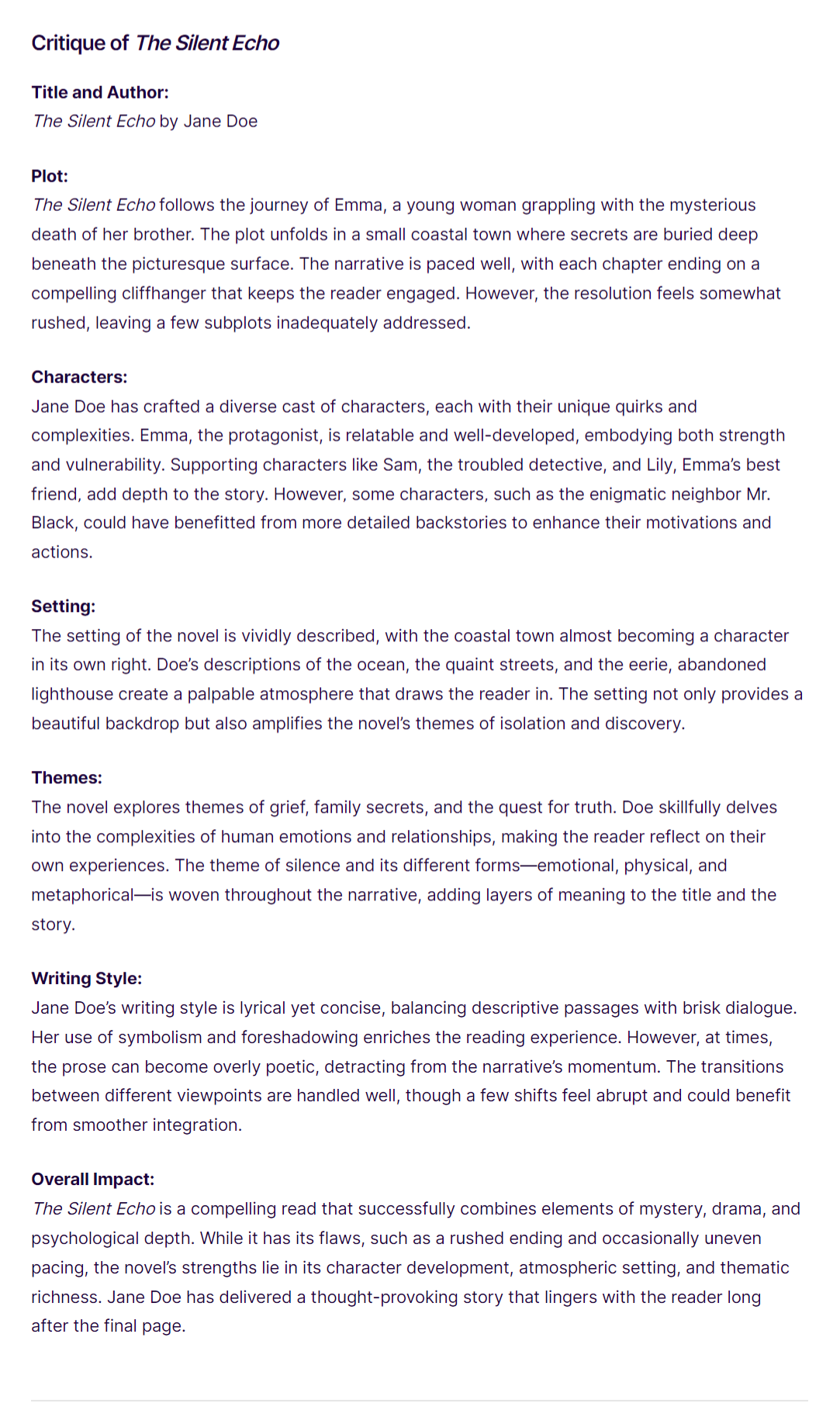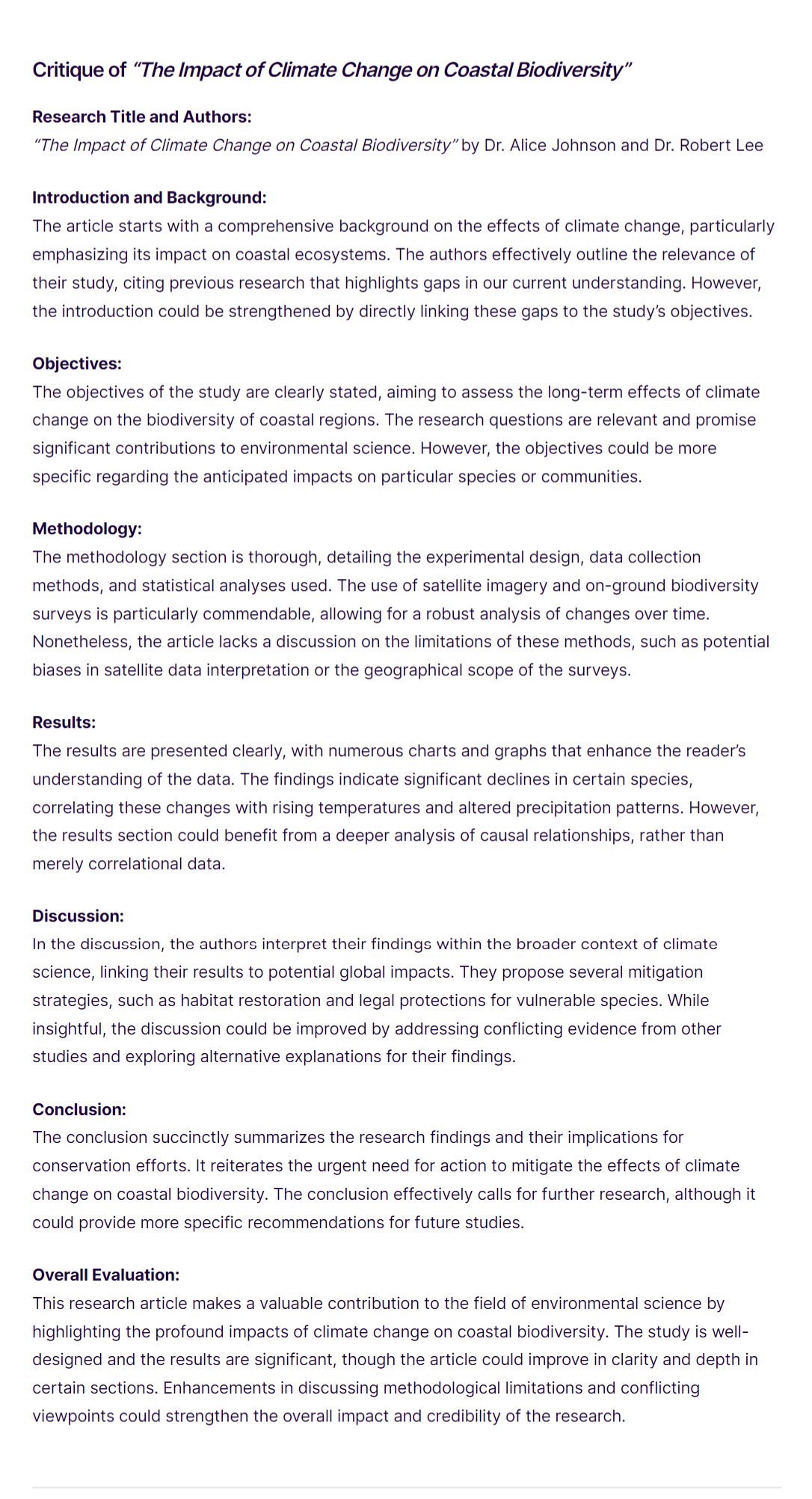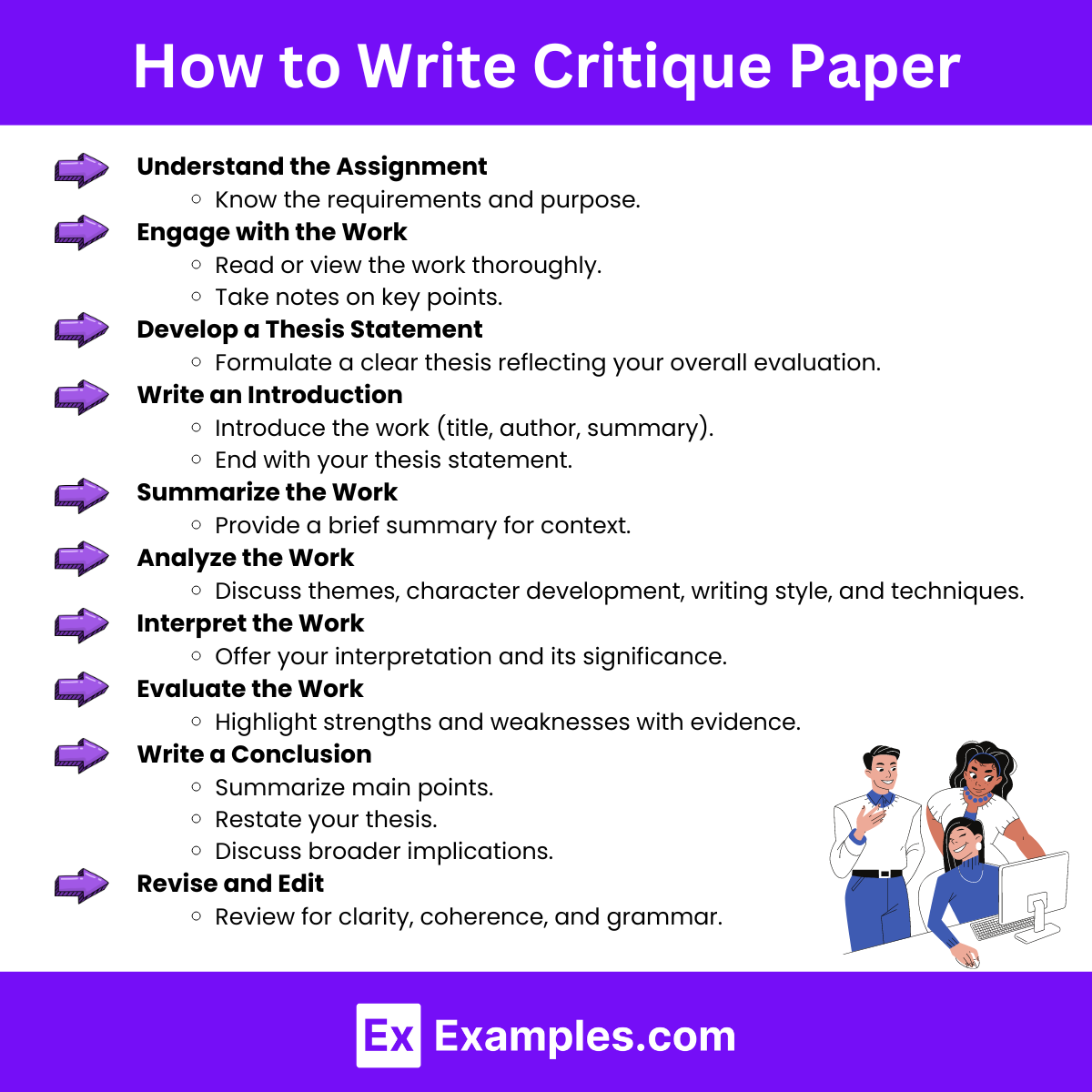Critique Paper

A critique paper is an analytical essay focusing on evaluating and interpreting a piece of work, such as an article, book, film, or painting. The aim is to assess the work’s strengths and weaknesses, often comparing it to relevant standards or other works in the field. The writer should provide a balanced analysis, supporting their observations with evidence, to inform readers about the work’s value and significance.
Critique Paper Free PDF Bundle
What is a Critique Paper?
A critique paper is an analytical evaluation of a work, focusing on its strengths and weaknesses. It requires critical thinking to assess and discuss the work’s effectiveness and provide recommendations for improvement, often backed by evidence.
Types of Critique Paper
Critique papers can vary widely in focus and approach, depending on the subject and purpose. Here are some common types:
- Literature Critique: Evaluates books, articles, and other written materials, focusing on theme, style, and contribution to the field.
- Art Critique: Analyzes artworks in terms of technique, style, symbolism, and emotional impact.
- Film Critique: Examines films, discussing elements like narrative, directing, acting, and cinematography.
- Performance Critique: Reviews live performances such as plays, concerts, or dance shows, commenting on the performance, direction, and production values.
- Research Article Critique: Assesses scientific studies or academic research, focusing on methodology, data analysis, and the validity of conclusions.
- Business Critique: Looks at business practices, products, or company strategies to evaluate effectiveness and suggest improvements.
Purpose of Critique Paper
A critique paper serves several important academic and intellectual purposes, contributing to both the writer’s understanding and the broader scholarly community’s discussion on a subject. Here are the primary purposes of a critique paper:
- Analytical Thinking: Writing a critique paper encourages deep analytical thinking. It requires the writer to not only summarize the content of a work—be it a book, article, film, or art piece—but also to analyze its components critically. This process involves assessing the strengths and weaknesses of the work, understanding its structure, and evaluating its impact.
- Critical Engagement: A critique paper fosters engagement with ideas and arguments presented by others. Through critique, a writer interacts with the work’s themes, methodologies, and conclusions, providing a personal interpretation and positioning it within a larger scholarly context.
- Developing Arguments: One of the main goals of a critique paper is to develop and articulate a coherent and reasoned argument. The writer must present a clear thesis or main argument about the work being critiqued and support this thesis with evidence, logical reasoning, and systematic analysis.
- Enhancing Understanding: Writing a critique helps in deepening the writer’s understanding of the subject matter. By analyzing different aspects of a work and connecting them to broader themes and knowledge, the writer gains a more comprehensive insight into the topic.
- Scholarly Contribution: Critique papers contribute to academic discourse by adding to the diversity of interpretations and perspectives on a particular work or topic. This can influence how a work is understood in academic and professional fields, potentially leading to new insights and developments.
- Improving Writing and Research Skills: The process of writing a critique paper enhances a writer’s research and writing skills. It involves gathering information, synthesizing insights, formulating arguments, and composing a structured document—all essential skills in academic and professional settings.
- Preparation for Professional Activities: Especially in fields like literature, art, and film studies, critique papers prepare students and professionals to engage in critiques and discussions, which are common professional activities. This preparation can be crucial for career in academia, criticism, journalism, and beyond.
Critique Paper Format
A critique paper generally follows a structured format to ensure a thorough evaluation and clear presentation of thoughts. Here’s an outline of the typical format along with an example for a research article critique:
1. Introduction
- Background: Provide context for the work being critiqued.
- Thesis Statement: Present your main argument or overall impression of the work.
- Overview of the Work: Briefly describe the main points of the work.
Example:

Free PDF Download

Free PDF Download
Critique of a Scientific Research Article

Free PDF Download
Critique Paper Examples for Students
Providing students with examples of critique papers can help them understand how to effectively analyze and evaluate different types of work, such as literature, films, research articles, and more. Here are three examples of critique paper topics, each tailored to a specific subject, that could be useful for students learning to write critiques:
Critique Paper Examples for Short Story
Creating a critique for a short story involves analyzing elements such as plot, characters, setting, themes, and the author’s writing style. Here are three examples of critique papers for short stories that can help students learn to evaluate and interpret literature effectively:
- Critique of “The Lottery” by Shirley Jackson
- Critique of “Harrison Bergeron” by Kurt Vonnegut
- Critique of “The Yellow Wallpaper” by Charlotte Perkins Gilman
Feminist Critique Paper Examples
Feminist critique papers provide insightful analyses on literature, media, or cultural practices through the lens of feminist theory, highlighting issues of gender equality, representation, and the experiences of women. Here are three examples of feminist critique paper topics, each tailored to examine different subjects with a focus on feminist perspectives:
- Feminist Critique of “Pride and Prejudice” by Jane Austen
- Feminist Analysis of “Mad Men”: A Look at Gender Roles in 1960s America
- Gender and Power in “Game of Thrones”: A Feminist Perspective
Art Critique Paper Examples
Art critique paper examples offer structured evaluations of various artworks, including paintings, sculptures, and photographs. These examples analyze themes, techniques, and emotional impact, providing insights into the artist’s intentions and the work’s significance. They serve as guides for understanding and articulating critical perspectives on art.
- Critique of “Starry Night” by Vincent van Gogh
- Critique of “The Thinker” by Auguste Rodin
- Critique of “Migrant Mother” by Dorothea Lange
Critique Paper Examples for Books
Critique paper examples for books provide detailed analyses and evaluations of various literary works, including novels, non-fiction, and classics. They examine themes, character development, writing style, and overall impact, offering insights into the strengths and weaknesses of each book. These examples guide readers in developing their own critical perspectives.
- Critique of “To Kill a Mockingbird” by Harper Lee
- Critique of “Sapiens: A Brief History of Humankind” by Yuval Noah Harari
- Critique of “Pride and Prejudice” by Jane Austen
Critique Paper Examples for Novel
Critique paper examples for novels offer in-depth analyses and evaluations of fictional works across genres. They explore themes, character development, plot structure, and writing style. These examples help readers understand the novel’s strengths and weaknesses, providing a framework for developing thoughtful, balanced critiques of literary fiction.
- Critique of “1984” by George Orwell
- Critique of “The Great Gatsby” by F. Scott Fitzgerald
- Critique of “Beloved” by Toni Morrison
Characteristics of Critique Paper
A critique paper is a detailed analysis and evaluation of a work, such as a book, article, film, or painting. It goes beyond merely summarizing the work by also providing a critical discussion regarding the quality and impact of the work. Here are some essential characteristics of a well-crafted critique paper:
- Analytical Focus: A critique paper primarily analyzes and evaluates the subject matter rather than just summarizing it. It discusses what the work does, how it does it, and how effectively the purpose of the work is achieved.
- Evidence-Based: Critiques are not just based on opinion; they are supported by evidence from the work itself. This might include quotations, examples, and detailed observations that back up the critique’s claims and conclusions.
- Balanced Argumentation: While it’s important to discuss what you perceive as the weaknesses of the work, a good critique also acknowledges its strengths. This balanced view helps to avoid bias and gives the paper credibility.
- Clear Structure: Like any formal piece of writing, a critique paper should be well-organized. It typically includes an introduction that states the work being critiqued and the main points of the critique, a body that discusses each point in detail, and a conclusion that summarizes the critique and may suggest broader implications or future directions.
- Critical Perspective: The critique should offer a distinct perspective that reflects critical thinking. It should engage with the work’s themes, techniques, and impact, providing a deeper understanding or new insights that go beyond the surface.
- Contextual Awareness: A critique considers the work in its broader context. This might include the historical, cultural, or academic context of the work, discussing how these elements influence the creation and reception of the work.
- Objective Tone: While personal responses can be included in a critique, the tone should remain objective and professional. The critique should focus on the work itself and its merits or faults, rather than on the author or creator as an individual.
- Thesis Statement: A strong critique paper features a clear thesis statement that guides the analysis. This statement typically outlines the main argument or viewpoint of the critique and sets the tone for the discussion.
- Engaging Writing: Effective critiques not only provide insights but are also engaging to read. They use persuasive language to make their points and maintain the reader’s interest throughout the paper.
- Reflective Insight: Beyond evaluating the work, a critique often reflects on its significance within a larger context or discipline. It may discuss how the work contributes to ongoing debates, trends, or theories within the field.
How to Write Critique Paper

Writing a critique paper involves a systematic analysis of a work (like an article, book, film, or painting), focusing on evaluating its various components and expressing your point of view. Here’s a structured guide on how to write a high-quality critique paper that’s SEO-friendly and well-suited for readability:






